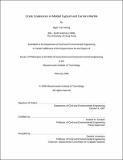Crack coalescence in molded gypsum and Carrara marble
Author(s)
Wong, Ngai Yuen
DownloadFull printable version (76.98Mb)
Other Contributors
Massachusetts Institute of Technology. Dept. of Civil and Environmental Engineering.
Advisor
Herbert H. Einstein.
Terms of use
Metadata
Show full item recordAbstract
This thesis investigates the fracturing and coalescence behavior in prismatic laboratory molded gypsum and Carrara marble specimens, which consist of either one or two preexisting open flaws, under uniaxial compression. In previous experimental studies, the determination of crack types (shear/tensile) was mainly based on the identification of fractographical features on the crack surfaces. In the present study, a high speed video system was used, which allowed one to precisely observe the cracking mechanisms.Seven crack types, which were characterized by different nature (shear/tensile) and orientations were identified to initiate from the pre-existing flaws in gypsum and marble in the present experimental study. Nine crack coalescence categories with different crack types and trajectories were also identified. The flaw inclination angle (beta), the ligament length (L), i.e. intact rock length between the flaws, and the bridging angle (a), i.e. the inclination of a line linking up the inner flaw tips, between two flaws, have all shown to have different effects on the coalescence patterns. Comparing the fracturing and coalescence behaviors in the two tested materials, tensile fracturing generally occurs more often in marble than in gypsum for the same flaw pair geometries.One of the pronounced differences observed between marble and gypsum during the compression loading test was the development of macroscopic white patches prior to the initiation of macroscopic cracks in marble, but not in gypsum. With the use of the scanning electron microprobe (SEM) and the environmental scanning electron microprobe (ESEM) techniques, the development of white patches and their evolution into macroscopic tensile cracks in marble, and the initiation of hair-line tensile cracks and their evolution into macroscopic cracks in gypsum were studied and compared. (cont.) The SEM study identified that the white patches in marble were associated withnmicrocracking zones (process zones). The parallel ESEM study on gypsum showed that the extent of process zone development associated with macroscopic tensile cracking wasnless. The different extents of process zone development, related to the inherent material strength and textural properties, are hypothesized to be the key factors in leading to different macroscopic fracturing behavior in gypsum and marble.
Description
Thesis (Ph. D.)--Massachusetts Institute of Technology, Dept. of Civil and Environmental Engineering, 2008. This electronic version was submitted by the student author. The certified thesis is available in the Institute Archives and Special Collections. Includes bibliographical references.
Date issued
2008Department
Massachusetts Institute of Technology. Department of Civil and Environmental EngineeringPublisher
Massachusetts Institute of Technology
Keywords
Civil and Environmental Engineering.